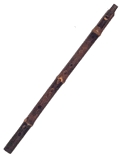How to make a dong flute
The traditional Dong flute is mostly made of water bamboo, but also made of purple bamboo, golden bamboo or yellow withered bamboo. The length and thickness of the flute are not fixed.

When making the Dong flute, the yellow withered bamboo or purple bamboo that was cut down in August is generally used. The bamboo joints are required to be long and uniform in thickness. After drying in the shade or steaming, a slope-shaped mouthpiece is opened at the thicker end, 5 cm away from the mouthpiece. A square whistle hole is opened, and the pipe wall above the hole is broken to form a rectangular groove with a depth of 1 mm and a width of about 5 mm. Bamboo strips are placed on both sides of the bamboo waste, covered with bamboo pieces and fixed with bamboo stalks to form an air intake. The reeds are made of thin bamboo sheets and fixed to the lower half of the whistle with bamboo to form a whistle. The sound hole is opened on the pipe body below the whistle. The distance from the sixth hole to the orifice is taken as the degree of the circumference of the lower end of the orifice. The four holes are equidistantly arranged, the fifth hole is closer to the fourth hole, and the sound range can reach two octaves.
With the same shape, there are Wageruo from the Wa ethnic group, the sister Xiao from the Miao ethnic group, and the recorder from the Tajik ethnic group.
 渝公网安备 50010702504639号
渝公网安备 50010702504639号